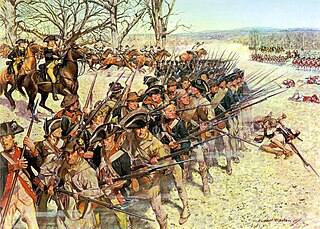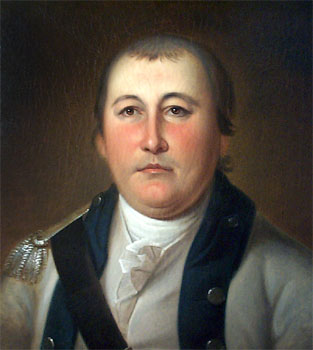
The Patriot is a 2000 American epic historical war film that is written by Robert Rodat, directed by Roland Emmerich, and starring Mel Gibson, Chris Cooper, Heath Ledger and Jason Isaacs. The story takes place mainly in rural Berkeley County, South Carolina, and depicts Benjamin Martin (Gibson), an American colonist opposed to going to war with Great Britain but, along with his adult son (Ledger), gets swept into the American Revolutionary War when his home life is disrupted, and one of his sons is murdered by a cruel British officer (Isaacs). Rodat has said Martin is a composite character based on four historical men: Andrew Pickens, Francis Marion, Daniel Morgan and Thomas Sumter.

The Battle of Guilford Court House was on March 15, 1781, during the American Revolutionary War, at a site that is now in Greensboro, the seat of Guilford County, North Carolina. A 2,100-man British force under the command of Lieutenant General Charles Cornwallis defeated Major General Nathanael Greene's 4,500 Americans. The British Army, however, suffered considerable casualties.

The Battle of Camden, also known as the Battle of Camden Court House, was a major victory for the British in the Southern theater of the American Revolutionary War. On August 16, 1780, British forces under Lieutenant General Charles, Lord Cornwallis routed the numerically superior American forces led by Major General Horatio Gates about four miles north of Camden, South Carolina, thus strengthening the British hold on the Carolinas following the capture of Charleston.

William Washington was a cavalry officer of the Continental Army during the American Revolutionary War, who held a final rank of brigadier general in the newly created United States after the war. Primarily known as a commander of light dragoons, he led mounted troops in a number of notable battles in the Carolinas during the campaigns of 1780 and 1781.

Sir Banastre Tarleton, 1st Baronet was a British general and politician. He is best known as the lieutenant colonel leading the British Legion at the end of the American Revolutionary War. He later served in Portugal and held commands in Ireland and England.

The Battle of Kings Mountain was a military engagement between Patriot and Loyalist militias in South Carolina during the Southern Campaign of the American Revolutionary War, resulting in a decisive victory for the Patriots. The battle took place on October 7, 1780, 9 miles (14 km) south of the present-day town of Kings Mountain, North Carolina. In what is now rural Cherokee County, South Carolina, the Patriot militia defeated the Loyalist militia commanded by British Major Patrick Ferguson of the 71st Foot. The battle has been described as "the war's largest all-American fight".

The British Legion was an elite British provincial regiment established during the American Revolutionary War, composed of Loyalist American troops, organized as infantry and cavalry, plus a detachment from the 16th Light Dragoons. The unit was commonly known as Tarleton's Legion, after the British officer who led it on campaign, Lieutenant Colonel Banastre Tarleton. It was a unit the size of a regiment, consisting of artillery, cavalry, and light infantry, and able to operate independently.

The Battle of Cowpens was an engagement during the American Revolutionary War fought on January 17, 1781 near the town of Cowpens, South Carolina, between American Patriot forces under Brigadier General Daniel Morgan and British forces, nearly half American Loyalists, under Lieutenant Colonel Banastre Tarleton, as part of the campaign in the Carolinas. The battle was a turning point in the American reconquest of South Carolina from the British.

The Battle of Waxhaws was a military engagement which took place on May 29, 1780 during the American Revolutionary War between a Patriot force led by Abraham Buford and a British force led by Banastre Tarleton near Lancaster, South Carolina. Buford's men consisted of Continental Army soldiers, while Tarleton's force was mostly made up of Loyalist troops. After the two forces sighted each other, Buford rejected an initial demand to surrender. Tarleton's cavalrymen launched a charge against the Patriot troops, which led many of Buford's men to throw their arms down in surrender. However, as Tarleton was shot under his horse during the charge, his infuriated soldiers attacked their Patriot opponents, killing several.

The Battle of Fishing Creek, also called the Battle of Catawba Ford, was an American Revolutionary War battle fought on August 18, 1780, between American and British forces including the 71st Foot. It was fought near the junction of Fishing Creek and the Catawba River in South Carolina. British forces under Banastre Tarleton surprised the militia company of Thomas Sumter, killing a significant number, taking about 300 captives, and very nearly capturing Sumter, who some say was asleep at the time of the attack.
Pyle's Massacre,, was fought during the American Revolutionary War in present-day Alamance County on February 24, 1781. The battle was between Patriot troops attached to the Continental Army under Colonel Henry Lee and the Loyalist North Carolina militia commanded by Dr. John Pyle. Due to the unique uniform design of his forces, the Loyalists mistakenly thought Colonel Lee was the expected British cavalry commander, Banastre Tarleton, who was known to be en route to reinforce Pyle. When Lee's men opened fire, they took Pyle's force totally by surprise. This resulted in an extremely lopsided victory for Lee, and Pyle's command was scattered and routed.

The Battle of Charlotte was an American Revolutionary War battle fought in Charlotte, North Carolina on September 26, 1780. The battle took place at the Mecklenburg County Court House; which is now the site of the Bank of America tower at Trade and Tryon Streets in uptown Charlotte. An advance guard of General Charles Cornwallis' army rode into town and encountered a well-prepared Patriot militia under the command of William R. Davie in front of the court house. A skirmish ensued in which George Hanger, leading the British cavalry, was wounded. The small Patriot force, which had not intended more than token resistance, withdrew north toward Salisbury upon the arrival of Cornwallis and the main army.
The Battle of Lenud's Ferry was a battle of the American Revolutionary War that was fought on May 6, 1780 in present-day Berkeley County, South Carolina. All of the British soldiers who took part in the Battle of Lenud's Ferry were in fact Loyalists who had been born and raised in the colony of South Carolina, with the sole exception being their commanding officer Banastre Tarleton. The unit was known as the Loyalist British Legion, under the command of Lieutenant Colonel Banastre Tarleton. The Loyalist British Legion scattered a company of Patriot militia at Lenud's Ferry, a crossing point on the Santee River, north of which lies present-day Georgetown County.
The Battle of Hanging Rock was a battle in the American Revolutionary War that occurred between the American Patriots and the British. It was part of a campaign by militia General Thomas Sumter to harass or destroy British outposts in the South Carolina back-country that had been established after the fall of Charleston in May 1780.
The Battle of Wetzell's Mill was an American Revolutionary War battle fought on March 6, 1781, between detachments of Nathanael Greene's Continental Army and militia and Banastre Tarleton's Loyalist provincial troops in Guilford County, North Carolina.
Huck's Defeat or the Battle of Williamson's Plantation was an engagement of the American Revolutionary War that occurred in present York County, South Carolina on July 12, 1780, and was one of the first battles of the southern campaign to be won by Patriot militia.
The Battle of Wahab's Plantation was a surprise attack on a Loyalist camp, which included elements of the British Legion commanded by Banastre Tarleton, by Patriot militia under the command of William R. Davie on September 21, 1780. The owner of the plantation was militia Captain James A. Walkup who served as a guide for Davie prior to the attack. Confusion has arisen over the spelling of the name Wahab as there are many spellings of the surname including, Walkup/Wahab/Wauchope/Waughup. The Loyalists were camped on the west side of the Catawba River while General Charles Cornwallis' army had camped on the east side. Davie opportunistically decided to attack the Loyalist camp, and succeeded in driving them back in complete surprise and with heavy casualties. He retreated before the British regulars arrived. The latter, in revenge for the attack, burned down Captain Walkup's house.
The Battle of Fishdam Ford was an attempted surprise attack by British forces under the command of Major James Wemyss against an encampment of Patriot militia under the command of local Brigadier General Thomas Sumter around 1 am on the morning of November 9, 1780, late in the American Revolutionary War. Wemyss was wounded and captured in the attack, which failed because of heightened security in Sumter's camp and because Wemyss did not wait until dawn to begin the attack.

The Battle of Torrence's Tavern was a minor engagement of the American Revolutionary War that took place in what was the western portion of Rowan County, North Carolina, approximately 10 miles (16 km) east of the Catawba River near modern-day Mooresville in Iredell County. Torrence's Tavern was a part of the larger Southern campaign of the American Revolution, which, by 1780–1781 involved a series of clashes between the British Army and Loyalist militia and the Continental Army and Patriot militia in the Piedmont region of North and South Carolina.
Christian Huck (1747/8-1780) was a Loyalist soldier from Philadelphia during the American Revolutionary War known for Huck's Defeat.











